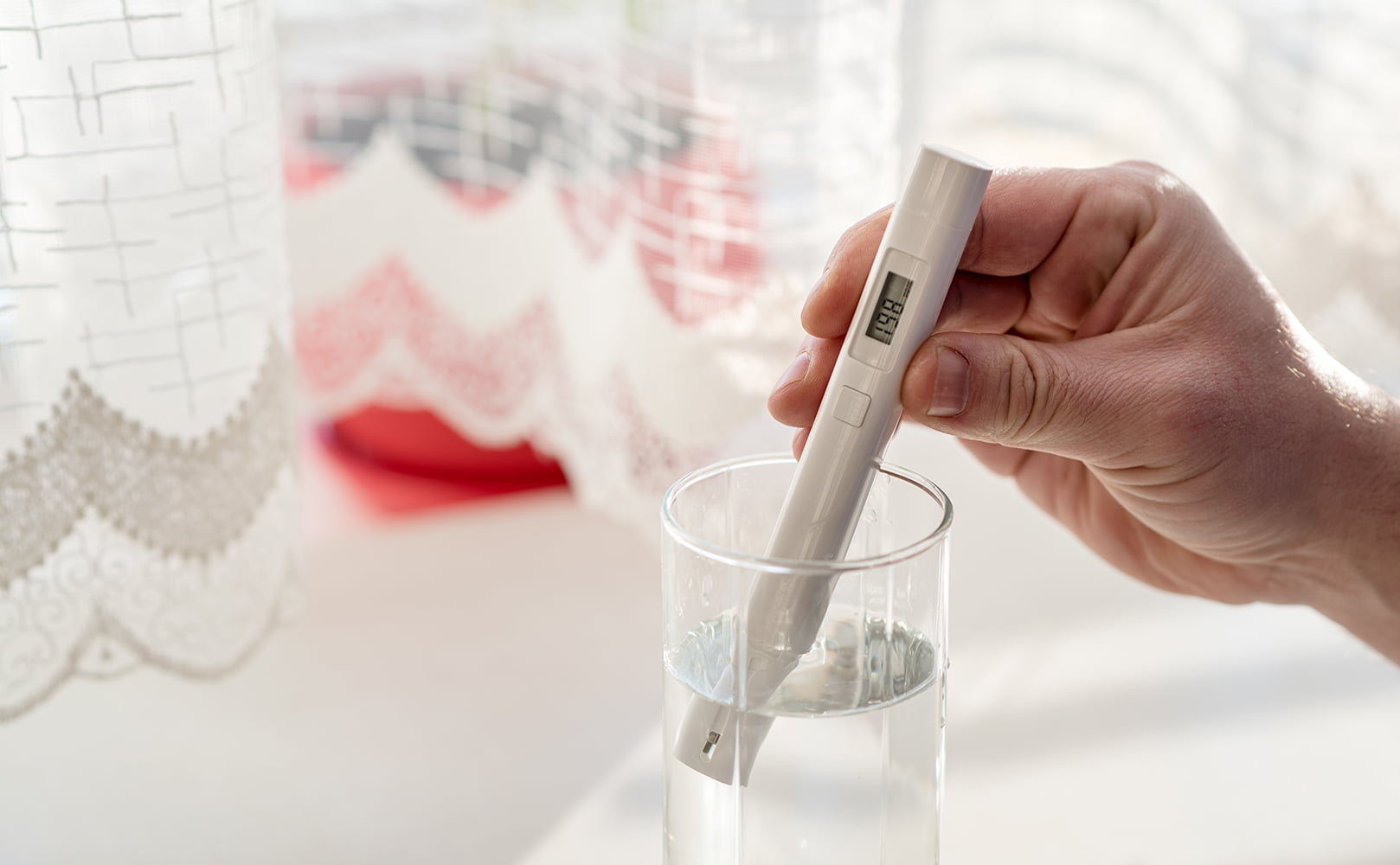What Is the TDS Level of RO Water in PPM? Let’s Find Out!
Written by: Alexandra Uta // Last Updated: Jul 14, 2023
This page may contain affiliate links. If you buy a product or service through such a link we earn a commission at no extra cost to you. Learn more.
Total dissolved solids (TDS) are a measure of the concentration of all dissolved particles in water.
Reverse osmosis purification is highly effective at removing such TDS from water, just not all of them.
The precise TDS level of RO water will depend on several factors, which this article will get into.
Key Takeaways
- RO water often has a TDS of 10-50 ppm.
- The exact TDS of your RO water will depend on several factors, including the TDS of your feed water, the feed water pressure and temperature, the condition of the RO membrane, as well as potential issues with your flow restrictor or drain line.
- High-end RO systems are capable of removing between 95% and 99% of total dissolved solids from water.
- You can measure RO water TDS using a TDS meter.
What Is the TDS Level of RO Water in PPM?
So, what is the TDS level of RO water in ppm?
RO water often has a TDS level of about 10-50 ppm, which is pretty low, but not zero.
The exact TDS level of RO water, however, will primarily depend on the TDS of the feed water, water pressure and temperature, as well as the type and condition of the RO membrane.
A typical thin film composite (TFC) reverse osmosis membrane in good condition will remove somewhere in the range of 95% to 99% of TDS. An old or fouled reverse osmosis membrane may only reduce 80% TDS or even less, which is one reason replacing RO membranes on schedule is so important.
What’s TDS?
TDS stands for total dissolved solids and is a measurement of the combined load of all organic and inorganic substances dissolved in water. There are literally dozens of different TDS types, but they can generally be categorized into: Salts, minerals, metals, and organic matter – even pesticides and disinfection byproducts.
What Are Total Dissolved Solids?
As explained above, TDS is an abbreviation of total dissolved solids and described the combined load of all organic and inorganic matter dissolved in a liquid like water.
That said, TDS reading does not indicate whether the dissolved solids are harmful or not. For example, TDS includes healthy minerals like magnesium, potassium, and calcium. This means TDS is simply a measurement of the total sum of dissolved solids in drinking water, with no reference to their makeup and health effects.
Where Do Total Dissolved Solids TDS Come from?
Drinking water naturally contains total dissolved solids and, generally, TDS levels in water are not a major cause of concern.
Mineral water often contains a TDS level of about 400 to 650 TDS. This comes from contact with underground rocks, which leads to some absorption of minerals into the water.
Contact with carbonate deposits like limestone will impart some carbonate into the water. Similarly, contact with salt deposits will increase the TDS level of water by adding sodium. These sources of TDS are essentially benign but can change the water’s taste.
Other sources of TDS which are indeed concerning are contact with sewage, urban and agricultural runoff, storm overflow, industrial and chemical runoff, or even pipe leaching. This may result in heavy metals such as lead or chromium 6 finding their way into your water supply.
How Do You Measure TDS in Reverse Osmosis Water?
TDS in RO water can be measured easily using several different methods.
TDS Meter
A TDS meter is a small handheld electronic device that measures TDS using electrical conductivity. TDS meters will give you a reading in parts per million (ppm) or milligrams per liter (mg/L) which is the same thing.
These devices will give you an accurate reading of the TDS level in your water, but they don’t give you any indication of the specific impurities or contaminants contained in your water. For this, you will need to conduct water testing to determine the precise TDS makeup.
Filter Paper
Measuring TDS using filter paper is an old-school method, but it works just as well as a TDS meter although it’s a bit more involved. You’ll need a clean glass container, filter paper, an evaporating dish, a clean stirring stick, a pipette, and a digital scale.
To measure TDS using filter paper:
- First, weigh the evaporating dish and note the measurement.
- Next, stir the water sample thoroughly to ensure the dissolved solids are dispersed equally.
- Then use the pipette to collect a 2-ounce sample from the stirred water.
- Pour the water sample into the container through the filter paper. Repeat this at least 3 times to ensure the dissolved solids are absorbed into the filter paper. Then transfer the filter paper to the evaporating dish.
- Now, weigh the evaporating dish with the extracted filtrate and note the reading.
The formula for water TDS:
TDS = (Dish Weight with Filter in mg – Empty Evaporating Dish in mg) x 1000 / Water Sample in mg
Why Checking TDS Levels in RO Water Is Important?
In general, TDS levels alone won’t give you that much information on drinking water quality. Excessively high levels of 1,000 ppm and up will be unpalatable, but excluding that simply knowing the TDS level doesn’t give you any information on the contaminants contained within water.
Still, when it comes to RO water, measuring TDS levels will give you a good idea of how effectively your system is working. If the system is operating properly a 90%+ reduction in TDS should be expected.
So, you can get a rough idea of how well your RO system is running by testing the TDS of your feed water, and then comparing it to the TDS of your RO filtered water.
Should You Aim for 0 TDS in RO Water?
There is no need to aim for 0 TDS in RO water. As mentioned previously, RO water can remove about 95-99% of TDS from water, so even if your system is working perfectly, there will still be some TDS left in the final product.
Generally, RO water will have a TDS level of 10 to 50 ppm, which is very low, but non-zero.
What Drinking Water TDS Level Is Healthy?
There is a range of TDS levels that are considered healthy. The EPA states that optimal drinking water should have a TDS of below 500 ppm.
RO water is on the low end obviously. Spring water or carbon filtered water will have a TDS of 50 to 150, and tap water will have a TDS of 150 to 400.
TDS Levels in Drinking Water – Chart
TDS levels in drinking water vary from 10 to 50 ppm on the low end for RO water, to 300 to 500 for unfiltered water. Above 500 is considered too high and requires filtration, and above 2,000 is considered unsafe to drink.
Why Is My RO Water TDS So High?
Several factors can be contributing to high TDS water after it’s passed through a reverse osmosis system.
- Feed water TDS is the largest factor when it comes to the TDS of your RO water. If the feed water TDS is extremely high, then even a perfectly running RO system will result in a relatively high TDS product water.
- Both feed water pressure and temperature will impact the operation of the RO membrane. Feed pressure needs to be at least 40 psi for the membrane to work, and 60 psi to work optimally. If it’s too low, the membrane won’t work properly and your permeate water TDS will be higher. Warmer water will also lead to higher TDS water.
- The condition of your RO membrane (and pre-filters) will also contribute to TDS levels. If the membrane and filters are older or clogged then TDS reduction will decrease.
- Issues with the flow restrictor or drain line can also cause the system to malfunction and lead to higher TDS levels in the output water.
Other Ways to Reduce or Remove TDS in Water
While reverse osmosis is highly effective at removing impurities including TDS from water, it doesn’t remove everything. If you want to get your water as close to zero TDS as possible, then water distillation or deionization after RO filtration are the only processes that will get you there.
Distillation
Water distillation will result in a TDS level of 0.5 ppm or less. The process involves boiling contaminated water to form steam, which leaves behind contaminant impurities while the steam cools and condenses to form purified water.
Deionization
Deionization is the only way to ensure a true 0 ppm TDS level. The process involves passing the water through both a positive and negative ion exchange resin bed. The ion-selective resins separate any ions from water. This results in exceptionally low TDS. However, non-ionic impurities cannot be removed with this method.
If you have any questions about TDS of RO water please don’t hesitate to leave a comment below!
Information provided on BOS is for educational purposes only. The products and services we review may not be right for your individual circumstances.
We adhere to strict editorial guidelines. Rest assured, the opinions expressed have not been provided, reviewed, or otherwise endorsed by our partners – they are unbiased, independent, and the author’s alone. We fact-check all content for accuracy. It is accurate as of the date posted and to the best of our knowledge.



